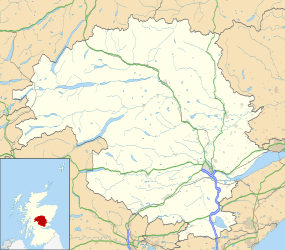Aberdalgie
| Aberdalgie | |
| Scottish Gaelic: Obar Dheilgidh | |
 Aberdalgie |
|
 Aberdalgie |
|
| OS grid reference | NO079201 |
|---|---|
| Council area | Perth and Kinross |
| Lieutenancy area | Perth and Kinross |
| Country | Scotland |
| Sovereign state | United Kingdom |
| Post town | PERTH |
| Postcode district | PH2 |
| Dialling code | 01738 |
| Police | Scottish |
| Fire | Scottish |
| Ambulance | Scottish |
| EU Parliament | Scotland |
Coordinates: 56°21′51″N 3°29′33″W / 56.364218°N 3.492391°W
Aberdalgie (Gaelic: Obar Dheilgidh, 'Confluence of the Thorn-Stream') is a small village in the Scottish council area of Perth and Kinross. It is located 4 kilometres (2.5 mi) southwest of Perth, to the south of the B9112 road close to the River Earn. Milltown Burn and Cotton Burn streams meet in the village centre.[1]
The village contains Aberdalgie Parish Church, the present building of which dates to 1773. Dupplin Castle lies to the southwest.
Notable landmarks
Parish church

The current Parish Church of Aberdalgie is dated 1773 but an earlier building is believed to have originally dated to the pre-Reformation period.[2] In 1618 it became the parish church of both Aberdalgie and Dupplin, when the parishes united.[2] It became a Category B-listed building in 1971.[3]
The T-plan church features two large centre round-arched windows and doors with circular windows either side. In 1929 the church interior was given a major renovation by Sir R.S. Lorimer.[3] Aberdalgie churchyard contains the family vault where medieval heads of Clan Oliphant are buried.[4] Prominent among them is Sir William Oliphant, the resolute Governor of Stirling Castle when it was defended against Edward I of England in 1304, during the Wars of Scottish Independence.[2] Other people buried here include the 1st, 2nd and 3rd Baron Forteviot and author Norma Octavia Lorimer (1863-1948).
Dupplin Castle
Dupplin Castle lies within the parish. The earliest known owner of the castle was Sir William Oliphant in the late 13th century. The castle was destroyed in 1461 and rebuilt.[5] It was again rebuilt in 1688, though retained its earlier tower and some remnants of the earlier castle. A fire gutted the castle in 1827, prompting a full rebuilding and restoration.[5] The current building is a house, completed in 1970.[6]
References
- ↑ Google (12 September 2016). "Aberdalgie" (Map). Google Maps. Google. Retrieved 12 September 2016.
- 1 2 3 "Aberdalgie, Old Parish Church". Canmore.org.uk. Retrieved 12 September 2016.
- 1 2 "Aberdalgie and Dupplin Parish Church, Aberdalgie". British Listed Buildings. Retrieved 12 September 2016.
- ↑ "Other Seats and Monuments". Clan Oliphant. Retrieved 12 September 2016.
- 1 2 "Dupplin Castle". Canmore.org. Retrieved 12 September 2016.
- ↑ "Dupplin Castle". Dundee City Council. Retrieved 12 September 2016.
| Wikimedia Commons has media related to Aberdalgie. |